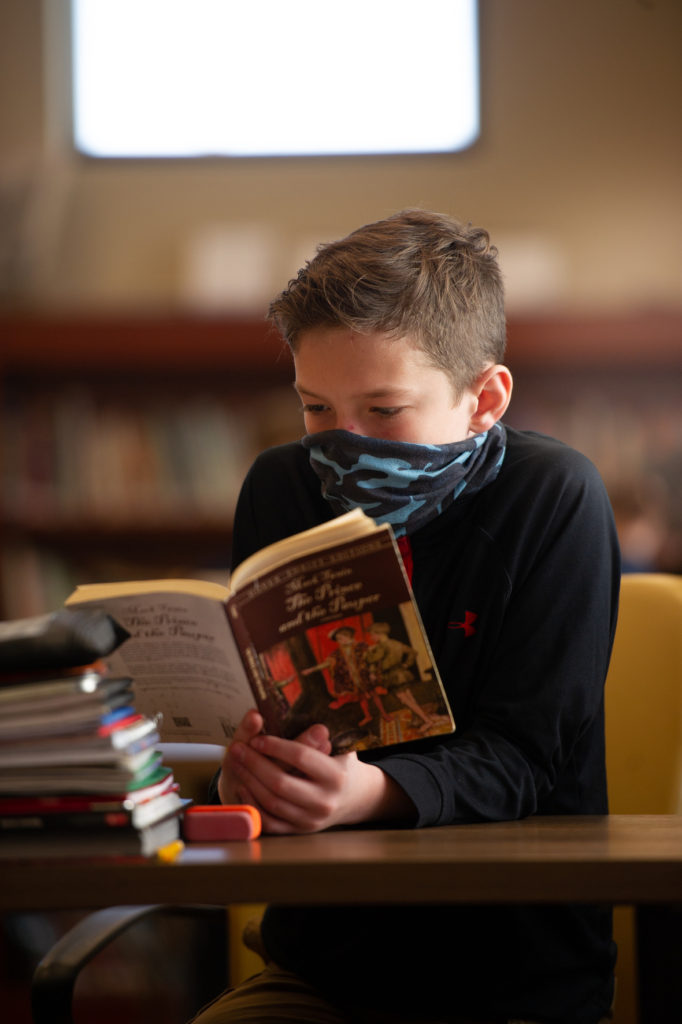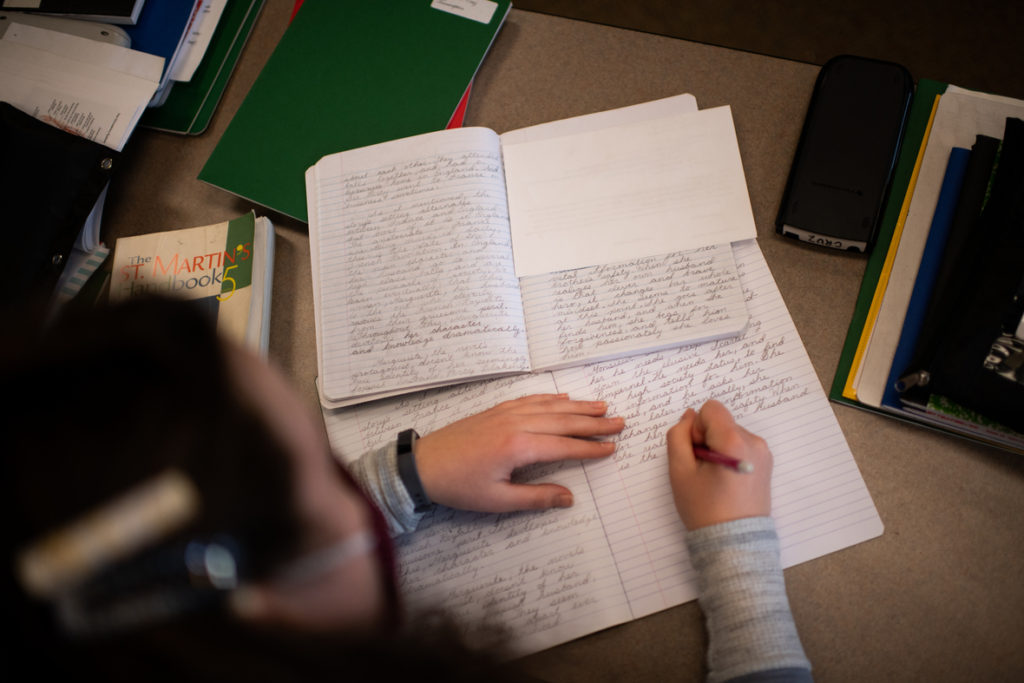Calvary students are daily asked to “tell back” what they have heard as a means of more deeply understanding the text, the ideas, and the author.
Why Narration Is A Critical Component Of The Learning Process
By Zach Ward
Director of Instruction, 8th Grade Teacher
Calvary Schools of Holland
“Once upon a time there was…”
“Long ago, in a distant land, there lived…”
“And so it happened, that each year thereafter…”
“It came to pass that…”
“And they lived happily ever after…”
Do these sound familiar? For many of us they may call to mind stories from childhood—moments of shared connection over a delightful tale with a loved one. Here’s another one…
“In the beginning, God created the heavens and the earth.”
So begins the story of creation, of relationship, of subsequent disconnection, and of God’s plan for redemption. It is of no little significance that scripture begins, neither with an epistle of encouragement, nor a prophetic word, nor a psalm of praise, but with a story—an account of God’s relationship to this world, written beautifully in narrative form.
And the God who reveals himself to us through story, through the written word, saw fit to create mankind in his own image. Fittingly, we are people of stories as well.
We are a story-telling people. It’s one of the primary means by which we relate to one another and make sense of our relationship to the world. Charlotte Mason, the educator upon whose pedagogical insights Calvary’s educational practices are based, has much to say on the centrality of relationship to education, and on storytelling as a primary means for assimilating knowledge, for cultivating those vital relationships.
She has this to say in her volume, Home Education:
“Narrating is an art, like poetry-making or painting, because it is there, in every child’s mind, waiting to be discovered, and is not the result of any process of disciplinary education. A creative fiat calls it forth. ‘Let him narrate’; and the child narrates, fluently, copiously, in ordered sequence, with fit and graphic details, with a just choice of words, without verbosity or tautology, so soon as he can speak with ease. This amazing gift with which normal children are born is allowed to lie fallow in their education. Bobbie will come home with a heroic narrative of a fight he has seen between ‘Duke’ and a dog in the street. It is wonderful! He has seen everything, and he tells everything with splendid vigour in the true epic vein; but so ingrained is our contempt for children that we see nothing in this but Bobbie’s foolish childish way! Whereas here, if we have eyes to see and grace to build, is the ground-plan of his education.” (231)
Attentive engagement with the words of a text is a powerful means of coming into relationship (recall that for Mason, relationship is central to education) with the mind of its author—a mind that is sometimes separated from us by time, space, and culture. When we ingest those words, and beautifully retell what an author has had to say (this is the process of narration), we have taken the first step toward a relationship with that author or the ideas brought forth in the text.
Amazingly, when we take the steps to participate in this fashion, and then we respond in some kind to the text, that author’s story becomes a part of our own. It becomes a part of us, of our spiritual being, in as much as a digested meal becomes a part of our physical being.
Now it should be noted that narration is not a summarization or dry recapitulation of the facts. Nor is a retelling full of personal editorial and commentary. There is a time in which one responds to the ideas that come forth in a text, but a rich understanding of what an author is actually saying is always a prerequisite to any sort of intelligent response.
Neither is narration, if it were possible (and for some it is), a rote word-for-word retelling. The commitment of scripture or poetry to memory is a wonderful personal discipline, but it is not the same as engaging in retelling what an author has to say—the idea that memorization is the same as narration is confusing a tool of the trade with the job itself. The spark of emotion which signifies the personal connection is a necessary component to the narration which is indicative of assimilated knowledge. Thus a beautiful retelling is the key.
And what constitutes such a retelling? Of what components is a good narration made?
Narration is made up of the components that one would find in any good story—a detailed narrative, told in logical sequence, and lifted up by the use of beautiful language.
When a person first begins to practice this exercise, there may be some initial discomfort and fatigue, as with any muscle which has not been given its proper exercise, but such symptoms give way to fluency and ease as muscle memory sets in and the exercise is taken more regularly.
Mason cautions against corrections from the listener, and alludes to the natural story-telling ability of children stating, “They not only narrate with spirit and accuracy, but succeed in catching the style of their author. It is not wise to tease them with corrections; they may begin with an endless chain of ‘ands,’ but they soon leave this off, and their narrations become good enough in style and composition to be put in a ‘print book’!” (233)
Though I have referred principally to narrative here—story communicated through the written and spoken word—the act of narrating or retelling is used as the “ground-plan” at Calvary in subjects beyond literature, the Bible, and history.
A student can also engage in the act of retelling the subject matter and composition of a painting, in vividly describing the form and function of an object from nature study, in retelling in an organized fashion the structure of a scientific diagram, or in articulating the flow of a physical, chemical, biological, or geological process.
When we ask students to “tell back,” we invite them to participate more fully in something which is unique to mankind, more deeply connects us as people to one another, and more deeply connects us as people to the Author of all good stories—to the author of Gospel—that is the “good story” that the Word took on flesh and dwelt among us, and that we can come to know Him and have a deep relationship with Him.
What a fitting thing to ponder over this Advent Season!
 Zach Ward is the 8th grade teacher and Director of Instruction at Calvary Schools of Holland. He has spent 20 years in teaching and education both domestically and abroad, working in various roles in bilingual classrooms, classical education, public school, administration, and Charlotte Mason education. He holds a master’s degree in education and is an Ambleside Master Teacher.
Zach Ward is the 8th grade teacher and Director of Instruction at Calvary Schools of Holland. He has spent 20 years in teaching and education both domestically and abroad, working in various roles in bilingual classrooms, classical education, public school, administration, and Charlotte Mason education. He holds a master’s degree in education and is an Ambleside Master Teacher.


